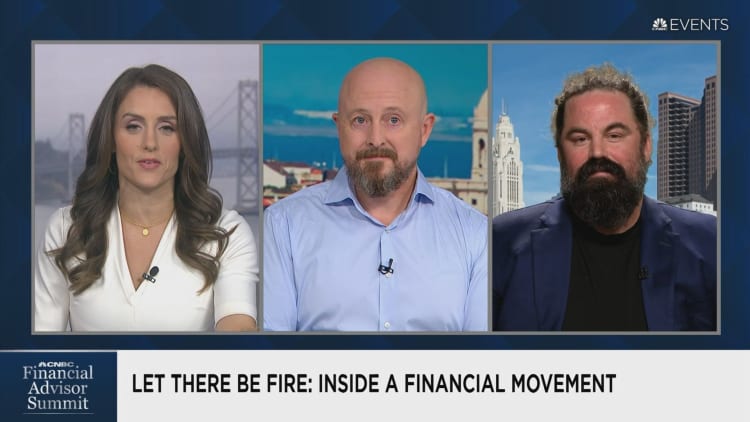
“His portfolio is still down from the April slump when everybody else’s accounts have gone up.”
Source link
FIRE
Jamie Dimon’s hot management take? Don’t be afraid to fire people—even though he was once fired by his mentor of 15 years
There’s no crying in baseball—and no crying in the boardroom either, according to JPMorgan Chase CEO Jamie Dimon.
In his 18 years at the helm of the world’s biggest bank, the Wall Street titan has cemented his reputation as an outspoken thought leader on finance and CEOship—and occasionally, the “pet rock” that is Bitcoin.
When it comes to management, Dimon believes leaders should be willing to dismiss employees who aren’t a good fit—and even he was once on the receiving end of the firing gun.
At a 2017 event at the Stanford Graduate School of Business, a Ph.D. student asked Dimon how he addresses bureaucratization within his bank. Dimon, who turned 68 today, shared what he thought was one of the toughest aspects of management: “You have to get rid of the bad people.”
Sometimes “bad” means a poor culture fit, and other times, it’s as simple as “they’re not good enough” at their job, Dimon said. Many managers are unwilling to get rid of the “bad people,” Dimon continued, and instead opt to reward their loyalty.
In order to achieve a true meritocracy staffed by top performers, Dimon says managers should think more like sports coaches. “In sports, if you’re not batting 250, you’re not going to be playing second base,” the bank chief said. “And it’s very easy, you take out a pitcher that’s not doing a good job.”
“In business, they are left in those jobs for a long time,” said Dimon, whose net worth is $2.1 billion according to Forbes.
Loyalty ≠ competence
“Loyalty is such a misnamed thing sometimes,” Dimon continued at the Stanford event.
As a young CEO, Dimon was asked why he demoted “Joe,” an employee who had been with the company for a long time and trained many other workers.
“How can we be loyal to you when you weren’t loyal to Joe?” an employee asked Dimon. “I couldn’t answer the question,” Dimon said at the Stanford event, so he slept on it and then called the employee the following day.
“If I was loyal to Joe and kept him in the job, and most people thought he just wasn’t doing a good job anymore, who am I being disloyal to?” Dimon recalls saying. “Everybody else and the customer.”
Lived experience
The billionaire was once on the receiving end of a high-profile firing himself—at the hands of a former mentor. While Dimon was an undergraduate at Tufts University, banker and family friend Sandy Weill hired him to spend the summer working at the investment bank Shearson—where Dimon’s father and grandfather both worked as stockbrokers.
After his graduation from Harvard Business School, Dimon followed Weill to American Express—turning down offers from Goldman Sachs, Morgan Stanley, and Lehman Brothers to do so. A few years later, Dimon followed Weill to Commercial Credit. By 1998, a 33-year-old Dimon was president and chief operating officer of Travelers, an insurance company.
“Then we merged with [Citigroup],” he said on the Coffee with the Greats podcast in 2020. Dimon was named Citi’s president following the merger—but a few months later, Weill, who had mentored him for 15 years at this point, asked him to resign during an executive weekend retreat.
“The problem was in 1999 he wanted to be CEO and I didn’t want to retire,” Weill told the New York Times in 2010. “I regret that it came to that. I don’t know what else could have been done except for him to be more patient.”
Though he was surprised by the firing, Dimon said he was “fine.” “It was my net worth, not my self-worth, that was involved,” he said on the podcast.
While out of a job, Dimon took up boxing and read biographies of leaders who had “truly suffered,” the Harvard Business Review reported in 2007. He interviewed for jobs at Amazon and Home Depot, according to CNBC, and became CEO of Chicago-based Bank One in 2000.
JPMorgan Chase acquired Bank One in 2004, and Dimon was named CEO of the bank in 2005—proving patience does pay off, eventually.
Fire away
Dimon has practiced what he preaches. In 2009, he abruptly ousted Bill Winters, the former co-head of investment banking at JPMorgan. Winters was considered a potential successor to the CEO role—he was even dubbed a member of Dimon’s “SWAT team” in a 2008 Fortune article about the bank’s response to the financial crisis.
The Wall Street Journal reported that Winters became the Dimon to Dimon’s…well, Weill, because he never believed in the universal banking model of combining an investment bank with a traditional lender.
Today, Winters is doing quite well for himself—he was named CEO of British bank Standard Chartered in 2015. In February, the bank reported statutory pretax profit of $5.09 billion and rewarded shareholders with a $1 billion share buyback.
And though Dimon has long joked “five more years” when asked if he plans to step down, it appears JPMorgan is laying the groundwork for what comes after. The bank announced a reshuffle of top executives in January, in order to “position the firm for the future” and “further develop the company’s most senior leaders.”
The front-runners to replace Dimon are widely reported to be Jennifer Piepszak, co-CEO of JPMorgan’s commercial and investment bank; and Marianne Lake, CEO of consumer and community banking. But it remains to be seen whether they’ll have the same baseball coach mentality as Dimon.
This story was originally featured on Fortune.com
The cryptocurrency industry has demonstrated a strong positive trend throughout the course of the week, with leading cryptocurrencies experiencing substantial increases in their market value. Moreover, the price of Solana (SOL) has exhibited superior performance compared to prominent cryptocurrencies, experiencing a notable increase of more than 34% in value over the course of one week.
Solana is a widely recognized Layer-1 network renowned for its scalability. The Solana network is characterized by its rapid confirmation times and has a thriving ecology and community. Over the course of the previous 24-hour period, there has been a notable increase of 15% in the trading volume of the SOL cryptocurrency, accompanied by a positive trend in its price.
Even with its continued stellar performance, Solana is still making waves in the market. According to data from CoinMarketCap, as of October 21, Solana’s spot price was nearly $29, up 9% compared to its previous 24-hour price.
Since the beginning of October, the Solana price has exhibited a confined trading range between $23 and $24, suggesting a lack of enthusiasm among investors for the aforementioned cryptocurrency. Subsequently, the coin underwent a decline in value, leading to a breach of its support level by the price.
The SOL price had a significant gain of 25% throughout the preceding 30-day period. At the time of writing, the market capitalization of the altcoin stands at $9,740,214,861. Based on the Solana price forecast, financial analysts see a potential increase to $31 by the end of 2023.
The current increase in SOL’s valuation is the result of multiple drivers. One key factor is the Solana ecosystem’s rapid expansion and advancement, especially in the field of decentralized finance (DeFi).
SOL market cap currently at $12.5 billion. Chart: TradingView.com
Frankie Candles provided the cryptocurrency community with a window into the extensive growth of the Solana network by sharing visual evidence that demonstrated the bustling activity occurring ‘behind the scenes’ within the Solana network.
This snippet is from my “Is Solana Dead” video. Despite the FTX fallout, $SOL still has a lot going on behind the scenes!
If you want to see the whole video, its on my channel, I will post the link on my X profile! pic.twitter.com/De6j5aNGxx
— Frankie Candles (@Frankie_Candles) October 19, 2023
Can The ‘Ethereum Killer’ Soar Higher?
The token has exhibited a proven trend reversal, transitioning from a bearish trajectory that commenced in July and persisted until September, to a positive trajectory. Following a significant shift in a critical level, the cryptocurrency that is believed to pose a threat to Ethereum may potentially enter a price range of $30.00, which holds psychological significance.
$SOL – Ive been extremely bullish all year.
It’s up 171% this year and we are about to test the big inverse head and shoulders at $30…. next major resistance would likely be $50, once confirmed. 1/ pic.twitter.com/2I0l92xFTR
— Raoul Pal (@RaoulGMI) October 20, 2023
Meanwhile, SOL is approaching a significant pattern testing phase. According to a seasoned macro investor, if the endeavor is successful, it may potentially pave the way for a substantial increase of 66% in value. The individual’s viewpoint is in accordance with the prevailing trend of optimism surrounding the crypto.
Raoul Pal, a famous macro investor and market analyst, has been very positive about SOL for most of the year. The price of the token went up 171% during this time. He also said that there are some signs that the great rise could get even bigger.
(This site’s content should not be construed as investment advice. Investing involves risk. When you invest, your capital is subject to risk).
Featured Image from Coin Culture
Why Crypto Mining Stocks Like Canaan and TerraWulf Were on Fire Today
What happened
Friday was an excellent day to be an investor in cryptocurrency mining company stocks. As a group, they surged ahead, with many rising at low double-digit rates.
Among these high flyers were Canaan (CAN 10.71%), TerraWulf (WULF 10.46%), and Cipher Mining (CIFR 10.68%), which all booked gains of nearly 11% on the day. Trailing closely behind was Iris Energy (IREN 9.52%) with its rise of just under 10%. The quartet trounced the uninspiring 0.3% dip of the S&P 500 index.
So what
It’s not like the market suddenly woke up on Friday and discovered the wonders of Canaan, TerraWulf, and their numerous mining peers. These stocks have been doing well for days due to a number of factors.
The first is the recent pop in popularity for cryptocurrencies in general; this is essential for miners, as without a bullish crypto market, the value of what they produce obviously falls.
Happily, developments on that front have largely been positive. Traditional finance companies are clamoring to get into the crypto game, with several pushing to establish exchange-traded funds (ETFs) for such assets. Among other efforts, top securities exchange operator Cboe Global Markets is teaming up with crypto market master Coinbase for a Bitcoin ETF.
These sorts of moves help to legitimize cryptocurrencies in general, and Bitcoin in particular, as attractive investible assets.
Another factor is the state of the U.S. macroeconomy. The latest figures from the government’s Bureau of Labor Statistics show lower-than-expected job additions. This eases fears of inflation heating up from wage increases, and with tamer inflation could come a cap on interest rates.
Higher rates are challenging for the cryptosphere, as they make other assets more attractive (Bitcoin and its ilk, after all, are still considered high on the risk scale).
Finally, crypto miners habitually release monthly operational updates for their investors. The June editions have come thick and fast, and for the most part they’ve indicated miners are continuing to push for growth. On Friday, for example, Iris Energy published its digest, revealing that the expansion of its Texas mining facility is on track to be completed in early 2024.
Now what
However, since cryptocurrencies are volatile investments by their nature, there is always a risk of a sudden (and possibly sharp) downturn. Inflation could heat up again, spurring the Federal Reserve and other central banking authorities to kick interest rates higher. More scandals could arise in a cryptoverse that has already seen quite a few of them.
So those considering investments in miners should bear this in mind. If they remain bullish on the future of digital money, though, mining stocks are a neat, sideways method of being involved in it.
Eric Volkman has positions in Bitcoin. The Motley Fool has positions in and recommends Bitcoin, Cboe Global Markets, and Coinbase Global. The Motley Fool has a disclosure policy.

Saving enough money to comfortably retire later in life may seem like a daunting, out-of-reach goal.
But some are challenging themselves to reach that goal even sooner than usual.
The FIRE movement — which stands for Financial Independence, Retire Early — is built on the idea that handling your money super efficiently can help you reach financial freedom earlier.
At a session during CNBC’s Financial Advisor Summit, two experts shared the steps they took to become wealthier than they had previously imagined.
More from FA Playbook:
Here’s a look at other stories impacting the financial advisor business.
“The FIRE movement is built around the principle that the higher your savings rate, the higher percentage of your income that you’re saving, the faster you’ll be able to reach financial independence,” said Grant Sabatier, author of “Financial Freedom,” who saved $1.25 million by age 30.
Alex Trias, a former attorney who now lives in Portugal, retired at 42, thanks to working long hours and saving aggressively, as well as financial boost from an inheritance and a small real estate investment.
Both Sabatier and Trias offered tips for how others can follow in their financial footsteps and retire early, if they want to join the movement, or just improve their financial outlook.
1. Boost your savings rate
Today, the average savings rate in the U.S. hovers around 2% to 5%, Sabatier noted.
That rate ensures most Americans will never be able to retire, he said. For those who are able to retire in their 60s or 70s, they may end up having much less money than they think.
But by saving about 50% of your income, the average person can reach financial independence in 10 years or less, Sabatier said.

Between 2010 and 2015, Sabatier saved up to 82% of his income and put it in a total stock market index fund, which he has allowed to compound and grow.
“Now I have way more money than I ever thought I would have saved and invested and more money than I will ever need,” Sabatier said.
2. Reduce your cost of living
To achieve a high savings rate, you need to reduce your living costs.
Sabatier did this by moving from a $1,700 per month apartment to an $800 per month apartment. He also opted to buy an $800 used car instead of a new one.
“I lived basically like a college kid in my mid-20s,” Sabatier said.
Trias took the concept even further, by relocating to Portugal, where he was able to cut the costs he faced living in the Washington, D.C., area.
His annual property taxes dropped from around $11,000 to about $184.
What’s more, Trias said his health insurance costs are now 10% to 15% of what you would pay in the U.S. for an unsubsidized plan.
Prescription costs are also substantially lower, with one drug that costed around $600 per month in the U.S. now taking just $60 of his budget, he said.
3. Increase your income
Of course, it is easier to save more when your income when your income is higher.
Sabatier said he realized he needed at least $23,000 per year to live on. But once he was making more than $250,000 per year, the savings started adding up very quickly, he said.
To get to that income level, Sabatier added a variety of side hustles, including helping a friend’s moving company, building websites and running Google ad campaigns. He also started writing online and building an online business.
“It’s never been easier in history to start a side hustle, because the barrier to entry is so low,” Sabatier said. “There’s so many different ways that you can make money online in ways that didn’t even exist 10 years ago.”
There are worse problems than waking up at 45 and having $1 million saved in the bank.
Grant Sabatier
author of ‘Financial Freedom’
In contrast, Trias made managing his portfolio and working for himself his first priority in order to reach his financial goals.
Both admitted the FIRE lifestyle comes with sacrifices and risks.
Consequently, it’s important to check in with yourself every year to evaluate whether or not the tradeoffs you’re making are worth it.
Not everyone sticks with the FIRE strategy until they can retire. Some do it for five or 10 years and then enjoy the freedom of having more money in the bank than they ever thought they would, Sabatier said.
“There are worse problems than waking up at 45 and having $1 million saved in the bank,” Sabatier said.





